Retail Holiday Newsletter

한눈에 보기
- Online retail sales so far in November are up almost 20% from a year earlier, and store sales grew 3.8% in October.
- Rising sales are placing pressure on a key holiday ingredient: seasonal labor.
- In this issue, we recap sales results from Thanksgiving weekend and discuss how retailers are tapping innovative strategies to attract, train, retain and pay their people—one of their largest investments—and how they are using technology to make their existing labor pool more efficient this holiday season and beyond.
Holiday Halftime Report
As Christmas approaches, retailers have reason to cheer. Following a strong October, early estimates suggest that consumers purchased in full force during Thanksgiving weekend. While the data from the weekend is still being tallied, here is what we know so far:
Retailers entered the holiday rush with momentum. Advanced retail in-store sales rose an estimated 3.8% in October from a year earlier, while e-commerce sales grew 17.5%. Online sales have climbed 19.9% so far in November, helped by robust demand during Thanksgiving weekend. Sales through desktop and mobile websites from Thanksgiving to Cyber Monday totaled $24.2 billion, up 23% from the year-earlier period, according to Adobe Analytics estimates. Cyber Monday sales alone rose an estimated 19.7% to $7.9 billion.
Thanksgiving weekend discounts were slightly higher than last year. Retailers slashed the prices of items they promoted in circulars by an average 50% on Black Friday, compared with 46% last year, according to research we conducted with Numerator. Together, we analyzed Black Friday promotions across a variety of product categories and found that retailers discounted children’s outerwear and lawn and garden supplies the most compared with last year (see Figure 1). In the hotly contested toys category, retailers boosted discounts to 43% from 37% last year in the hopes of winning former Toys ‘R’ Us shoppers. This trend was not universal: Discounts on electronics, a popular holiday gift category, were largely unchanged.
Retailers offered larger Thanksgiving weekend discounts this year than last year

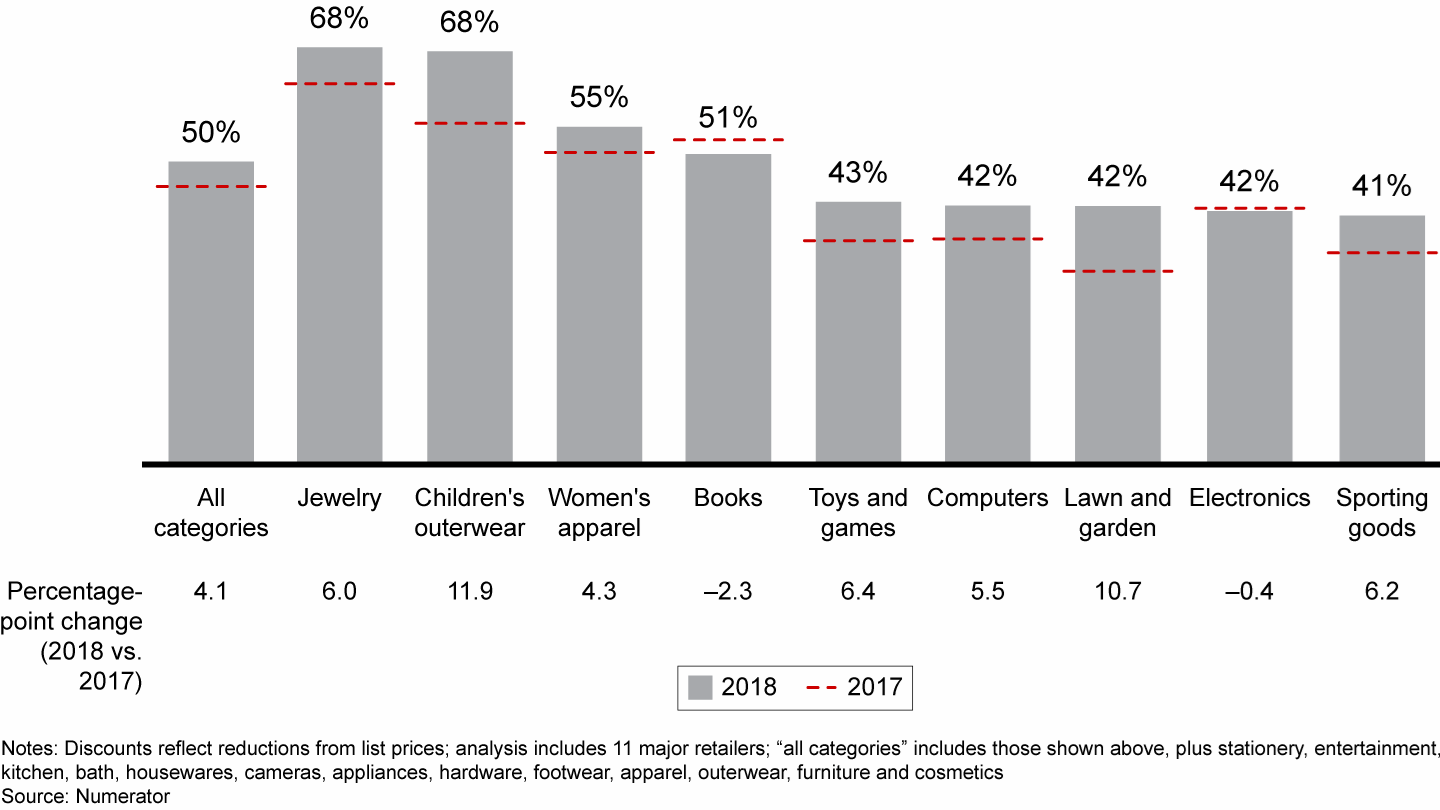
Foot traffic increased modestly. Average daily foot traffic for the first 25 days of November is up 2% from a year earlier at the 900 shopping centers, outlets and malls that we tracked with the help of Placer.ai. Most of this growth occurred in A- and B-grade malls—shopping centers with higher-end stores—where foot traffic increased 3% compared with last year. Traffic at C- and D-grade malls declined 1% during this period.1
Retailers are innovating with experiences. Many retailers are experimenting with unique in-store experiences and amenities to make shopping more fun and convenient. For example, the new FAO Schwarz megastore in New York features magic shows and a “baby doll adoption center,” in addition to its famous dance-on piano. To reduce the hassle of navigating a crowded lot, the Mall of America in Bloomington, Minnesota, recently introduced a parking system that uses colored lights to guide shoppers to open parking spots. While it is too early to tell if these particular experiments are working, we expect to see more customer experience innovation.
Top apps are gaining share. From Thanksgiving to Cyber Monday, total daily users of the 50 most-popular Android shopping apps rose 19% from the year-earlier period, and shoppers spent twice as much time on them, according to research we conducted with SimilarWeb. Mobile app use also outpaced visits to top retailers’ desktop and mobile websites, which climbed 2% and 10%, respectively, during the same period (see Figure 2). The gains have been limited to only a few retailers, with the top four apps—Amazon, eBay, the bargain marketplace app Wish and Walmart—capturing 80% of the growth (see Figure 3).
The outlook for the rest of the season remains strong. The robust sales growth we have seen in October and for the holiday season so far is likely to continue, given the strong macroeconomic environment. The recent California fires are likely to boost December sales as people rebuild homes and replace possessions.
More consumers used mobile apps to shop this year, especially during Thanksgiving weekend

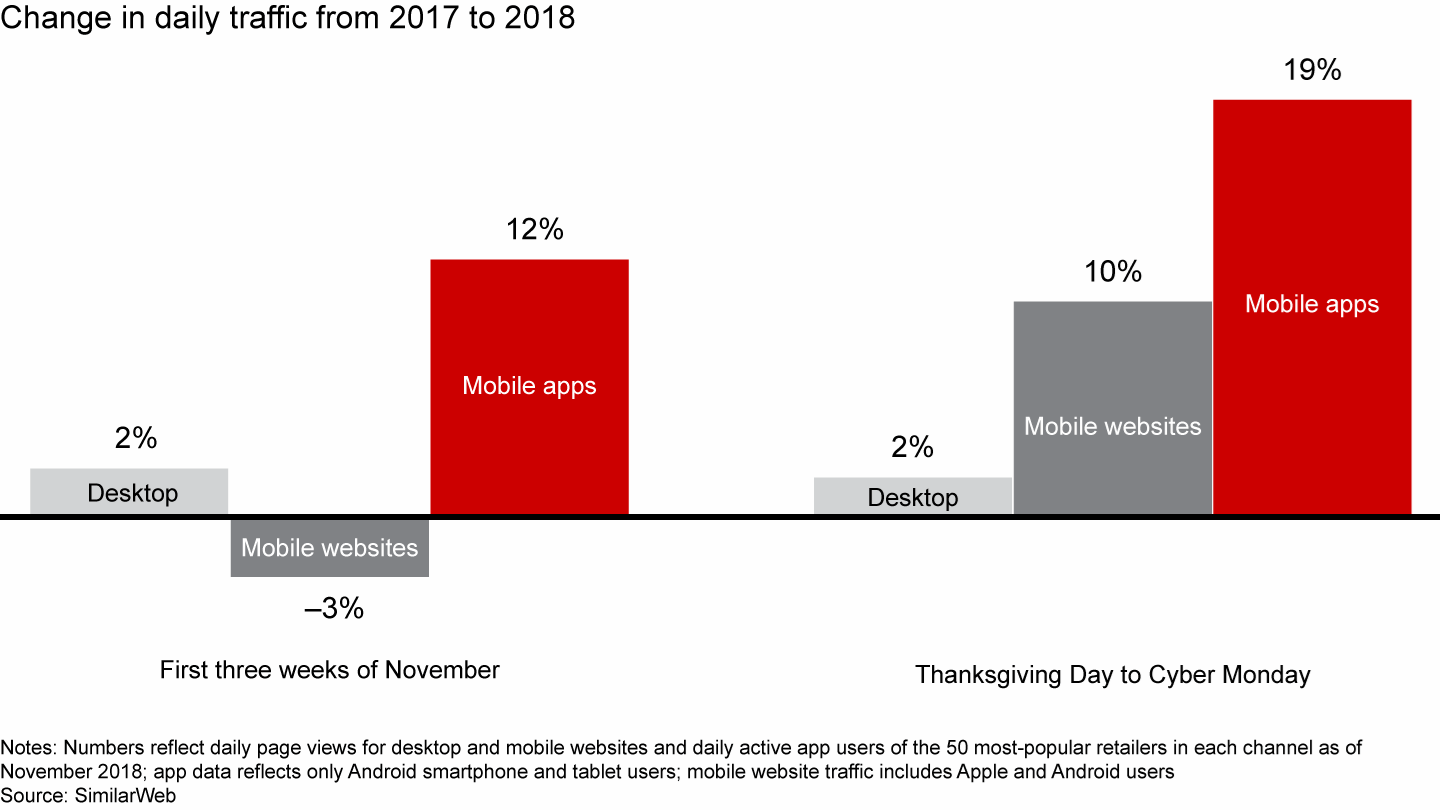
The top four apps accounted for most of the increase in Thanksgiving weekend app shopping

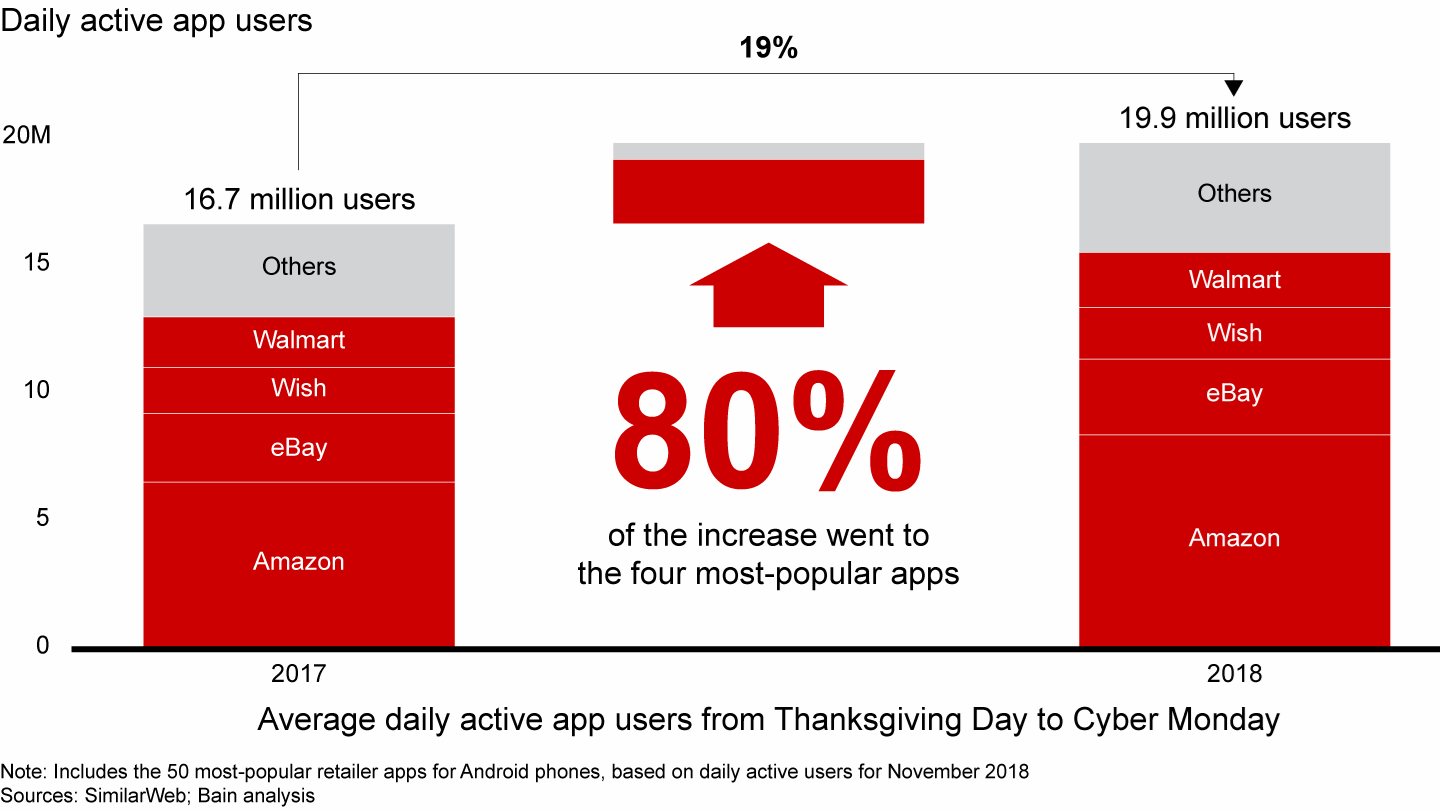
Holiday shopping magic requires more hands
During the crucial holiday months, navigating the tightest job market in two generations will be essential to meeting retailers’ profit goals. Last month, the National Retail Federation said it expected retailers to hire 585,000 to 650,000 workers for the holiday season, up to 12% more than last year, when one-quarter of retailers fell short of their hiring goals. Target said it aimed to hire more than 125,000 people for the holidays, 20% more than in 2017, and Nordstrom sought to add 75% more seasonal workers. Companies including Kohl’s and J.C. Penney started hiring for the holidays as early as June and July.
Without adequate staffing, companies risk attracting new customers only to disappoint them during the holiday rush with long checkout lines, empty shelves and insufficient coverage on the sales floor. With unemployment at a 49-year low of 3.7% in October and ride-sharing companies Uber and Lyft drawing more people to drive for extra cash, seasonal workers are harder to find and cost more to hire. If companies do not manage rising wages effectively, labor costs as a percentage of revenue could increase by 4 to 6 percentage points, and—absent other changes—wipe out the single-digit operating margins typical in the industry.
An uphill battle for talent
Store labor makes up about half of a retailer’s selling, general and administrative expenses, and many retailers prioritize managing costs over employee effectiveness and loyalty. Fifty percent of retail salespeople in the US earn less than $11.16 per hour, and one-third work part time. Beyond low pay, part-time employees also cite unpredictable schedules and weak management as common frustrations, based on Glassdoor reviews of industries that tend to hire the most seasonal help. Those factors have pushed turnover rates for part-time hourly store workers to 81% this year from 76% last year. When it comes to employee satisfaction, retail lags ride sharing, hospitality and delivery services (see Figure 4).
Retail employees are less satisfied than workers in other service industries

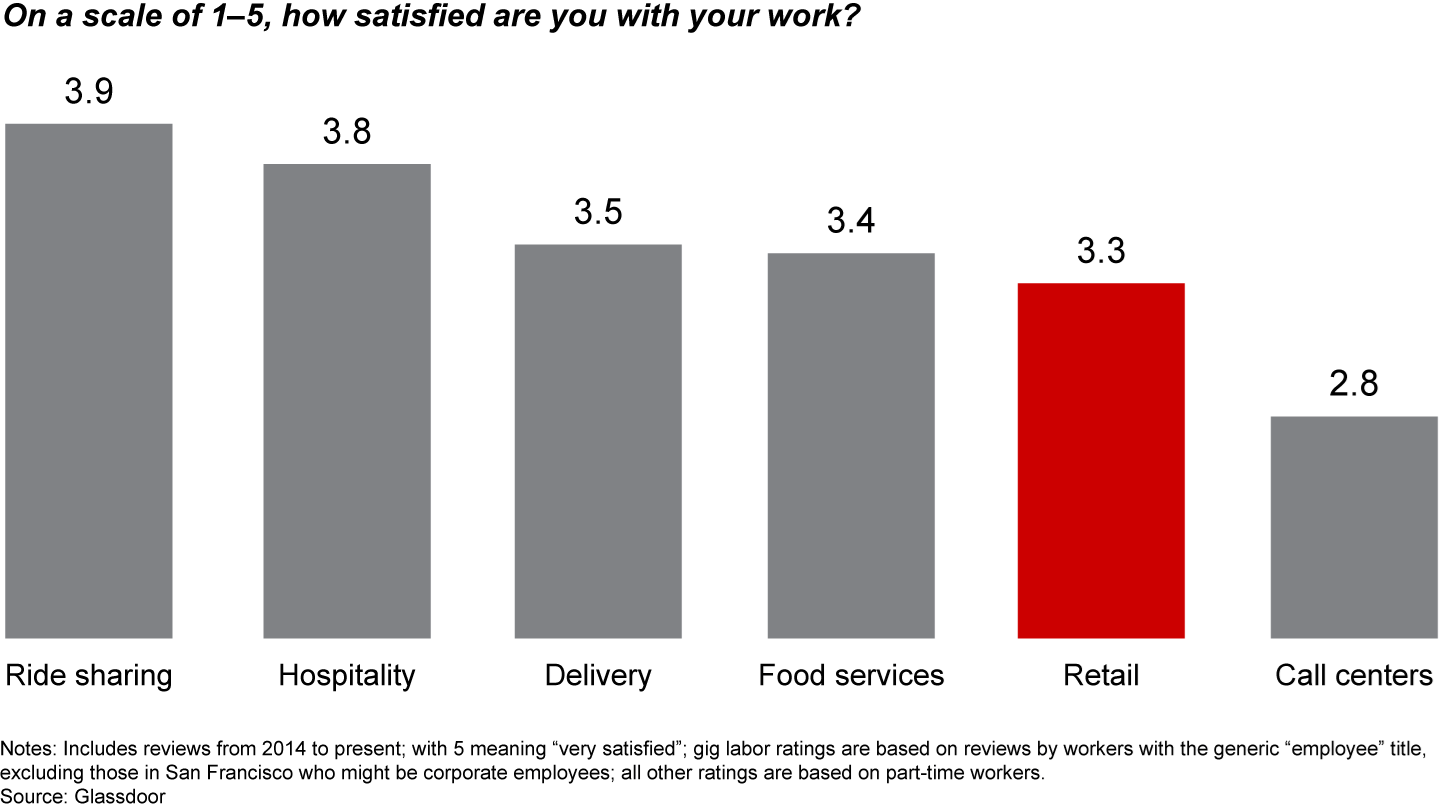
The talent war has forced many retailers to increase pay rates to compete. Retail wages have grown 2.3% annually over the last five years, outpacing inflation by 80 basis points. After the US government cut corporate tax rates, Walmart and Target boosted their hourly base wages to $11 and $12, from $10 and $11, respectively. Amazon made the biggest waves when it raised its hourly minimum to $15, effective November 1 (see Exhibit A). Target plans to reach the same mark by 2020.
Beyond higher wages, retailers have been offering more—and more creative—incentives to prospective employees this year, including:
- Richer bonuses or vacation packages. Macy’s made seasonal workers eligible for quarterly bonuses for the first time. J.C. Penney offered one week of paid time off to some seasonal workers.
- Better employee discounts. J.C. Penney made seasonal workers eligible for its 25% employee discount for the first time. Kohl’s advertised a 35% discount on select days to seasonal workers this holiday, on top of its 15% everyday discount offering.
- Unique perks. Ulta has been offering half-price haircuts, while Kohl’s provided turkey dinners to employees who worked on Thanksgiving Day. J.C. Penney raffled off everything from kayaks and diamond necklaces to all-expenses-paid vacations to destinations across North America.
Win with people, win with customers
Despite improvements in technology and the growth of e-commerce, people are still paramount to retail success. Employees build relationships with customers—providing a human touch that is hard to replace. A survey from Aspect Software found that 50% of UK shoppers prefer to interact with humans alongside technology when shopping in a store. Of course, human interaction requires the right humans; miserable employees can detract from an otherwise positive customer experience.
Providing the memorable experiences that customers will rave about on social media and to their friends demands engaged, even inspired, employees. After all, employees should be a company’s best advocates. Their enthusiasm rubs off on customers, encouraging them to come back and buy more. Return customers propel a company’s growth and reward employees for their efforts, creating a virtuous cycle (see Figure 5).
Employee and customer advocacy fuel a virtuous growth cycle

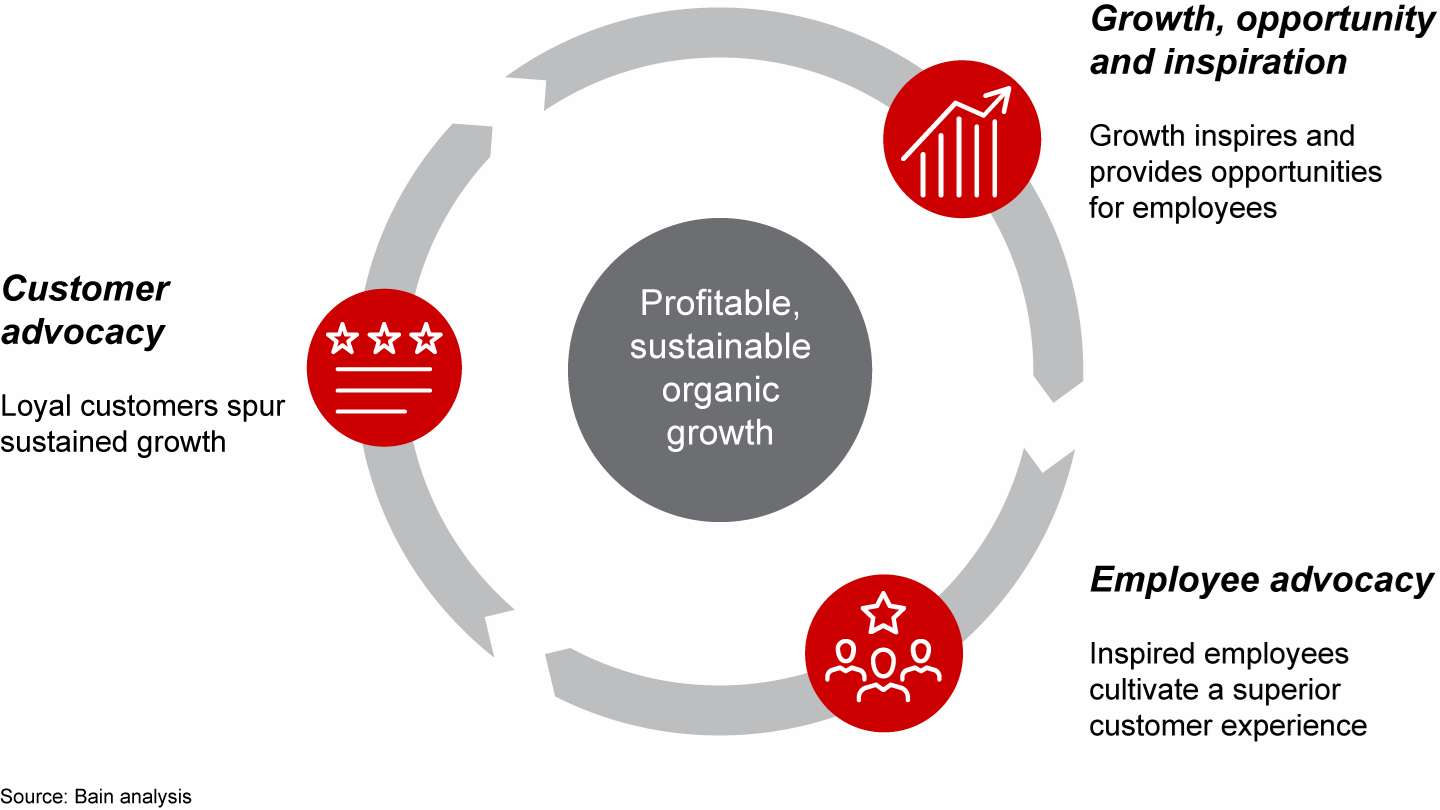
Customers who interact with highly engaged employees are up to 2.6 times more likely to recommend the company, according to a Bain survey. And companies with leading customer advocacy scores grow more than 2.5 times faster than the industry average. Conversely, poor in-store support hurts customer satisfaction and lowers sales, which might prompt a company to cut labor hours or training and further undermine its customer experience. This doom loop is hard to escape.
Successful retailers go beyond meeting their workers’ basic needs and inspire them to apply their energy, enthusiasm and creativity to delighting customers (see Exhibit B). Inspired employees are more likely to create memorable customer experiences and less likely to quit, reducing costly turnover and creating more value for customers and shareholders. The convenience store QuikTrip not only provides detailed feedback on employee and store performance, it encourages staff to find creative ways make customers happy, according to Massachusetts Institute of Technology professor Zeynep Ton, author of “The Good Jobs Strategy.” The result is a highly motivated workforce that feels empowered to improve the QuikTrip experience. QuikTrip’s voluntary employee turnover rate is less than 15%, significantly lower than the retail average of 60%.
Before a company can inspire its employees, it must meet their basic needs for safety, growth opportunities and fair pay, among others. That might sound obvious, but retailers have a lot to gain. Failing to meet employees’ basic needs can increase employee stress and turnover, according to the Good Jobs Institute at the Massachusetts Institute of Technology. The opposite is also true. Consider Costco, whose average hourly wage of $22.50 outstrips the $18.50 average for all retailers. The wholesale retailer also offers store employees subsidized health and dental insurance, and access to its retirement savings programs. The approach has satisfied employees and investors alike, with a Glassdoor rating that is 20% higher than those of peers and a return that has doubled the S&P 500 Index during the last five years.
Automating Santa’s workshop
Higher wages and benefits win raves from workers’ rights organizations, but those headlines usually tell only part of the story. For Amazon in particular, the increase strengthens one of the retail giant’s competitive advantages: its use of technology. Amazon, which also eliminated bonuses and company stock for existing warehouse workers, is betting that it can automate faster than its competitors. The company has expanded its use of robots in fulfillment centers by 25% since last year. It is also increasingly using “machine-driven merchandising,” ordering products automatically based on how fast they sell, vendor compliance metrics and other factors.
Will other retailers be able to keep pace? To maintain their margins, retailers must reduce nonlabor costs, cut labor hours or boost sales by making their remaining workforce more effective. This holiday, we see many retailers turning to technology to help find and train employees, automate store operations, and improve warehouse and delivery logistics.
Solutions to find and train employees
Gig platforms expand talent pools. Retailers are beginning to embrace the gig economy to hire workers almost instantly to complete discrete tasks. The startup Jyve connects retailers with on-demand workers who can perform in-store tasks on short notice. Supervisors can track “Jyvers'” progress in real-time from their computers or mobile devices, so they can learn about completed tasks faster and manage workflows better. While not all gig workers are suited for higher-end service tasks, retailers can use Jyve’s productivity data to stay connected with top performers and add them to their longer-term hiring pipelines. The Snag Work app offers open store shifts to more than 2 million active users. A similar app, Wonolo, acts as a temporary staffing service for companies such as apparel retailer Uniqlo and shipping company OnTrac.
Hiring apps simplify recruiting processes. Mobile hiring portals can increasingly screen résumés and manage interviews. Merlin, for example, handles everything from publishing listings to filtering candidates and scheduling interviews for retailers such as T.J. Maxx, Sherwin-Williams and The Vitamin Shoppe. Tools such as Paradox’s Olivia or Google’s Hire app use artificial intelligence to automate aspects of the hiring process. Retailers such as CVS and Staples use Paradox’s Olivia to screen candidates automatically, schedule interviews and even field questions about the job, helping recruiters find better candidates faster.
Virtual reality enhances training. Retailers are using simulations to better prepare employees for real-life situations. In September, Walmart announced it would use virtual reality techniques to train employees in its more than 4,700 stores. Through a 2017 pilot with the startup STRIVR, the retailer used virtual reality to simulate a Black Friday experience for trainees, helping them to prepare for the day’s chaos. Lowe’s is also using virtual reality to teach associates how to use in-store equipment, in the hopes of improving customer service.
Automating store operations
Digital price tags offer flexibility with less manual effort. Printed price tags historically made it impractical and costly to change prices frequently. French grocers wrestling with rising employee wages shifted years ago from printed price tags to digital displays, cutting the high labor costs of changing product prices. With technology prices falling and wage rates rising, this approach is beginning to take hold in the US as well. Best Buy has spent $30 million to roll out digital price tags at 20% of its stores. The technology can save the company as much as $10 million of merchandising people costs in the first year.
Computer vision aids planogram compliance, shelf restocking and more. Close-range computer vision technology now outperforms human eyes and holds promise as a labor-saving solution for many manual activities. The computer vision company Trax uses image-capturing technology to create digital store aisles, helping retailers audit their inventories and save valuable labor hours. Earlier this year, Alibaba unveiled its Futuremart store concept. At Futuremart, facial recognition cameras identify shoppers when they walk in. As they exit the store, the same cameras confirm their identity and RFID technology registers the items they have in hand. Facial recognition is also streamlining the payment process. Yum China recently expanded its “smile to pay” technology, which allows for payment through facial recognition software, to over 300 KFC stores across China.
Automating in-store pickup desks. While “buy online pick up in store” (BOPIS) options have become more popular, early renditions were often cumbersome and labor intensive. Consumers usually had to walk to the back of the store and wait for an employee to locate their items. To add convenience, retailers such as Walmart, Dick’s Sporting Goods and Home Depot are using self-service or automation to expedite the pickup process. By the end of the year, Walmart will have more than 700 pickup towers, large “vending machines” that retrieve online orders. Walmart is also partnering with Alert Innovation’s Alphabot technology to pilot robotic storage and retrieval to automate the order collection part of the process. Beyond in-store pickup for customers, integrating these technologies opens the door for Walmart to scale microwarehousing models over the long term.
Improving warehouse and delivery logistics
Robots increase speed. Retailers are further automating distribution centers and processing orders faster. Logistics company XPO, whose clients include Ikea and Zara, said in October that it would deploy 5,000 autonomous robots to help workers fulfill up to 48 orders at once, doubling the processing speed. Cainiao, a Chinese logistics company, opened a 700-robot warehouse to prepare for Alibaba’s Singles Day shopping event on November 11. And Kroger plans to build 20 automated warehouses in the US to fill online grocery orders. The grocer struck an exclusive partnership with Ocado, which has significant experience with robotic customer fulfillment centers in the UK.
Autonomous vehicles automate last-mile delivery. Moving goods from a transportation hub to their final destination accounts for an estimated 50% of a retailer’s total fulfillment costs. Within this so-called last-mile delivery, people are retailers’ greatest expense. Several retailers are already experimenting with autonomous vehicles, including cars and drones, to cut delivery times. Kroger has been testing how autonomous vehicles might help it deliver same-day and next-day orders in Arizona through a partnership with the start-up Nuro. Domino’s Pizza and 7-Eleven are working with Flirtey, which conducted the first drone delivery approved by the Federal Aviation Administration, to deliver food and drinks quickly, even during rush hour.

Retail Holiday Newsletter 2018
Bain’s annual Retail Holiday Newsletter series looks at the tactics and innovations that retailers are using to attract and delight shoppers.
While these technologies offer great promise, they also present executives with difficult decisions. Does the expected benefit justify the significant capital expenditure? Can the organization handle the change management required? Will this version of the technology stick or will it be outdated in two years? Is it better to build or to buy? And while the possibilities are endless, wallets have limits. Despite the uncertainty, leading retailers will not sit on the sidelines. They will take a measured approach to testing, scaling ideas that work and learning from those that do not. A clear strategy and strong execution will improve the customer experience and employee service.
Evaluating your people and technology strategies
Many retailers will face difficult people and technology decisions not only over the holidays, but also during the coming years. While every company is different, we recommend starting with the following blueprint:
Understand why customers shop with you. Every retailer must know who their customers are, what they care about, how they engage across shopping journeys, the unique value proposition the retailer offers them, and how the company competes with its peers. This perspective helps retailers identify experiences that should be physical rather than digital, and when to be best in class versus best in cost.
Embrace people as a critical asset. Leading companies consider their employees their biggest investment and constantly look for ways to motivate and inspire them. Putting this into practice requires companies to create a strong employee culture, which does not happen overnight. Key questions for executives to ask include: What energizes our best employees? Why do people leave? How does our compensation compare with competitors’? What do our customers say about our employees? Are there low-cost ways to delight the workforce? Are there policies I should change to show my employees that I trust and value them?
Boost employee productivity and effectiveness. Many retailers have yet to unlock the full potential of their employees simply because people spend too much time on activities that customers do not value, or because they lack the tools to succeed. Opportunities to increase revenue or decrease costs often succumb to complex processes or inadequate technology. Solutions start with simplification. Zero-basing what your company does and how it does it can reveal processes that you can streamline, eliminate or automate.
Create a customer experience system. Successful companies never stop innovating customer experiences. They innovate the business processes that enable those experiences. And they innovate the tools and technologies that power the business processes that enable those experiences. They engage the entire organization in serving the customer. They listen and act on ideas, managing change to achieve results.
Looking forward: Future release dates and topics
In our next issue, we will examine the latest marketing trends and continue to monitor holiday sales figures. Here is the breakdown of our last two issues:
- Issue No. 4 (mid-December): Merry Marketing
- Issue No. 5 (mid-January): Postholiday Recap and 2019 Outlook
Please let us know if you have any questions or would like to arrange a follow-up discussion on topics addressed in this newsletter or any other retail topics by emailing us at RetailHolidayNewsletter@bain.com.
Appendix
Amazon’s raise to $15 an hour is the latest in a long string of retailers’ minimum wage hikes

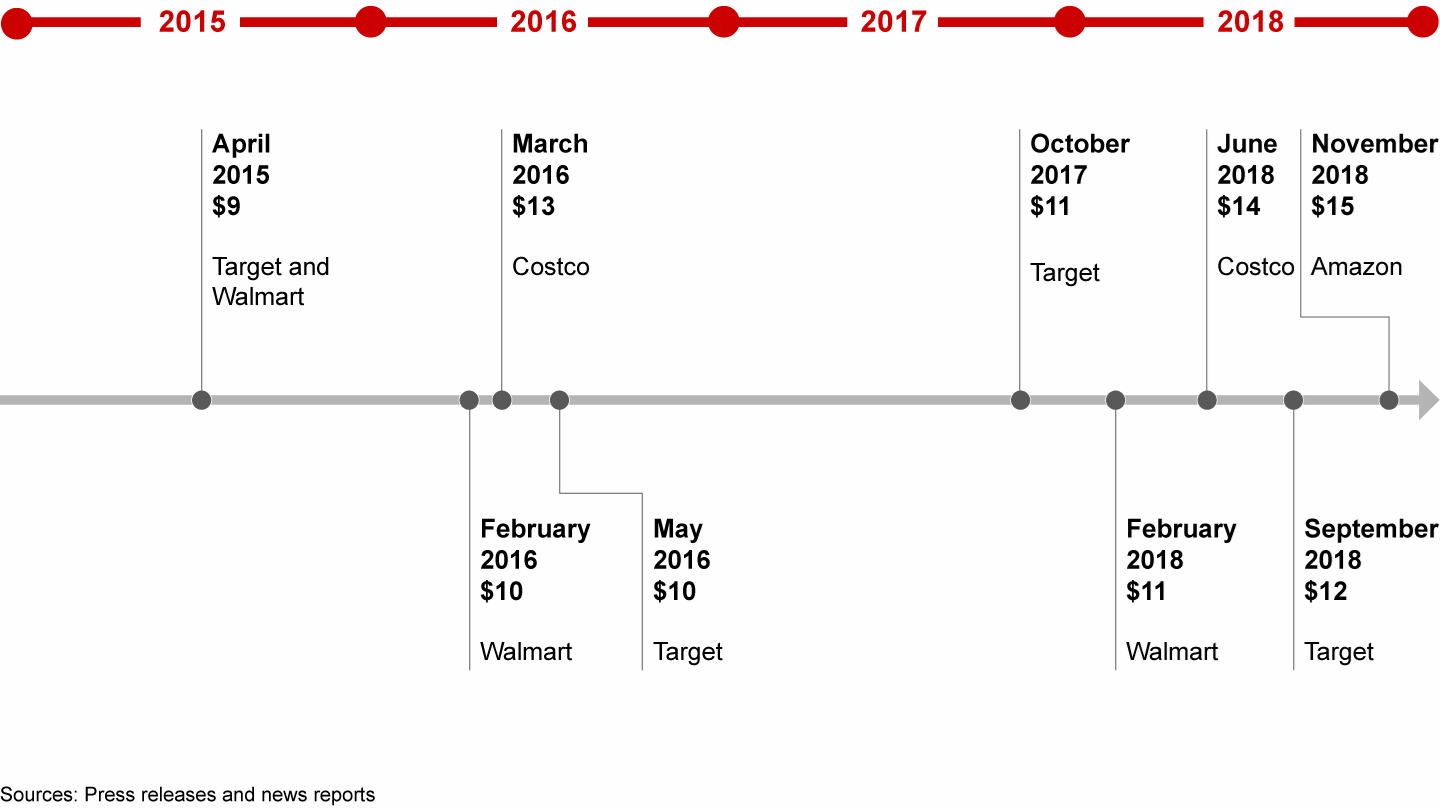
Successful retailers both satisfy and inspire their workforce

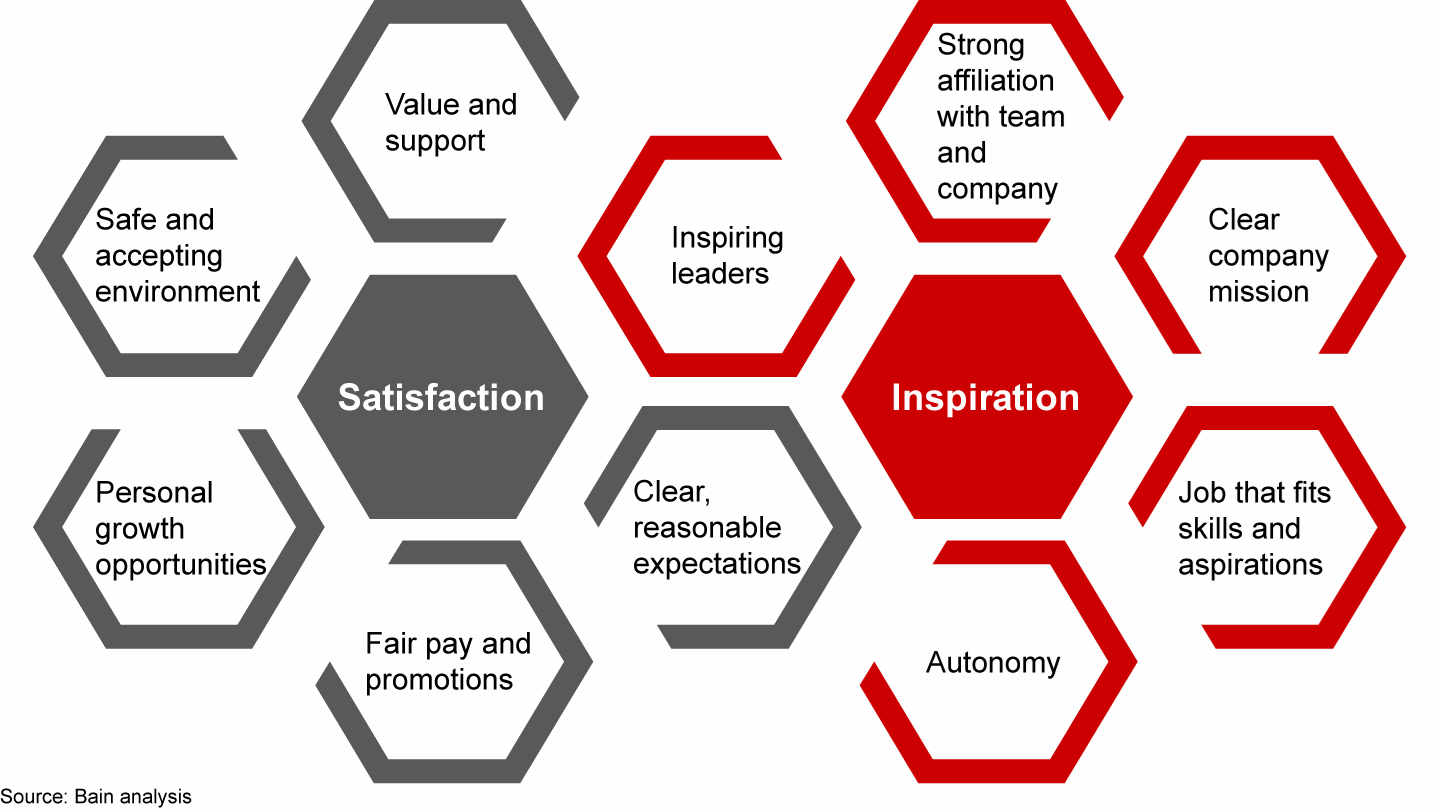
About Our Research Partners
Green Street Advisors, an independent research firm, advises participants in the commercial real estate industry, providing them with unbiased insights and excellent service. Green Street offers public market REIT research in North America and Europe, covering more than 120 REITs; the firm also provides US private market research on the top 50 metropolitan statistical areas. To learn more about Green Street, visit www.greenstreetadvisors.com.
Numerator is a market-intelligence firm that brings together omnichannel marketing, merchandising and sales data for brand, retail and agency clients. Owned by Vista Equity Partners, Numerator connects omnichannel purchase data (powered by the InfoScout OmniPanel) and comprehensive path data to deliver a detailed view of the consumer shopping and purchase experience. To learn more about Numerator, visit www.numerator.com.
Placer.ai is an advanced foot-traffic analytics platform that generates location-specific insights, helping retailers gain a deeper understanding of audiences and competition. Headquartered in Silicon Valley, Placer.ai enables its customers to make data-driven decisions based on precise human movement analytics. To learn more about Placer.ai, visit www.placer.ai.
SimilarWeb provides granular insights about websites and apps across all industries and in every region to help brands make better decisions. Companies use SimilarWeb to understand industry dynamics, reveal competitor strategies, benchmark performance and identify new opportunities. To learn more about SimilarWeb, visit www.similarweb.com.
-
Selected References (click to expand)
Bain & Company has included in this document information and analyses based on the sources referenced below as well as our own research and experience. Bain has not independently verified this information and makes no representation or warranty, express or implied, that such information is accurate or complete. Projected market and financial information, analyses and conclusions contained here are based (unless sourced otherwise) on the information described above, and Bain’s judgments should not be construed as definitive forecasts or guarantees of future performance or results. Neither Bain & Company nor any of its subsidiaries or their respective officers, directors, shareholders, employees or agents accept any responsibility or liability with respect to this document.
Abramovich, Giselle. “Online Sales Up 23% YoY This Thanksgiving Holiday Weekend.” CMO by Adobe, November 27, 2018.
“Adobe Analytics Data Shows Cyber Monday Broke Online Sales Record with $7.9 Billion.” Adobe, press release, November 26, 2018.
Armstrong, Paul. “Google Updates ‘Hire’ With AI, Schedules Interviews 84% Faster.” Forbes, June 19, 2018.
“Average Hourly Earnings of All Employees: Retail Trade.” Federal Reserve Bank of St. Louis, graph, accessed November 9, 2018.
“Average Hourly Earnings of Production and Nonsupervisory Employees: Retail Trade.” Federal Reserve Bank of St. Louis, graph, accessed November 9, 2018.
Barnes, Lauren. “Consumers want blend of technology and human input at retail.” PCR, October 25, 2018.
Bandoim, Lana. “Kroger And Ocado Plan To Build First Automated Robot Warehouse In Ohio.” Forbes, November 19, 2018.
Bhattarai, Abha. “In holiday ‘war for talent,’ retailers offer turkey dinners and haircut deals to lure temp workers.” The Washington Post, September 28, 2018.
Bhattarai, Abha. “Minimum wages are rising. Pay for experienced retail workers is not.” The Washington Post, August 2, 2018.
Bhattarai, Abha. “Now hiring, for a one-day job: the gig economy hits retail.” The Washington Post, May 4, 2018.
Belvedere, Matthew J. “FAO Schwarz puts a new spin on its dance-on piano as part of Friday’s splashy NYC comeback.” CNBC.com, November 13, 2018.
“Characteristics of minimum wage workers, 2017.” US Bureau of Labor Statistics, March 2018.
Chesanek, Carissa. “At Alibaba’s Cashier-Free Store, A Smile Gets Customers A Discount.” PSFK blog, April 30, 2018.
“Chief HR Officer Stephanie Lundquist on What Raising Target’s Minimum Wage Means for our Team and Company.” Target, press release, March 6, 2018.
“Consumer Price Index for All Urban Consumers: All Items.” Federal Reserve Bank of St. Louis, graph, accessed November 12, 2018.
Coombs, Casey. “Amazon has nearly doubled its robot army to more than 80,000 in four months.” The Puget Sound Business Journal, June 12, 2017.
Darnell, Darci, and Rob Markey. “Net Promoter for People: Give Employees a Voice, Get Their Best.” Bain & Company, February 7, 2018.
Evans, Katie. “US online sales grow an estimated 17.5% in October.” Digital Commerce 360, November 15, 2018.
Fishman, Jake. “Best Buy Price Tags Go Digital.” Gap Intelligence Blog, October 4, 2018.
Gilsdorf, Kimberly, Fay Hanleybrown and Dashell Laryea. “How to Improve the Engagement and Retention of Young Hourly Workers.” Harvard Business Review, December 6, 2017.
Green, Dennis. “Walmart is doubling down on a futuristic way to train employees.” Business Insider, September 20, 2018.
Harlow, Tim. “No more circling: Mall of America lights the way to open parking spots.” The Minneapolis Star-Tribune, November 13, 2018.
“Invest in People.” Good Jobs Institute, website.
“JCPenney Hiring Over 39,000 Seasonal Associates and Introducing New Reward Packages.” J.C. Penney, press release, October 2, 2018.
Kapner, Suzanne, and Inti Pacheco. “Out of Stock This Holiday Season: Store Workers.” The Wall Street Journal, September 17, 2018.
Kharpal, Arjun. “Firm linked to Alibaba opens China’s biggest robot warehouse to help deal with Singles Day demand.” CNBC.com, October 30, 2018.
“Kohl’s Gears Up for an Exciting Holiday Season.” Kohl’s, press release, September 28, 2017.
“Kohl’s Provides Holiday Hiring Update.” Kohl’s, press release, September 27, 2018.
Martin, Chuck. “Lowe’s Extends Virtual Reality Training From Shoppers to Employees.” MediaPost, February 6, 2018.
Nassauer, Sarah. “Store Traffic Falls Again on Black Friday but Not All News Is Bad News.” The Wall Street Journal, November 25, 2018.
“Nordstrom Aiming to Fill 13,650 Positions Before the Holidays.” Nordstrom, press release, October 25, 2017.
“Nordstrom To Host Company-Wide Hiring Day On Friday, October 19.” Nordstrom, press release, October 18, 2018.
“NRF forecasts holiday sales will increase between 4.3 and 4.8 percent.” National Retail Federation, press release, October 3, 2018.
Peterson, Hayley. “Walmart is unleashing 2 key weapons against Amazon in 700 stores.” Business Insider, April 5, 2018.
Pisani, Joseph. “Amazon to cut bonuses, stock benefits as it raises wages.” The Associated Press, October 3, 2018.
Reagan, Courtney. “Desperate for holiday help, retailers give away diamond necklaces, kayaks and $5,000 vacations to attract workers.” CNBC.com, October 29, 2018.
“Retail Employee Turnover Up as Black Friday and Holiday Shopping Season Nears, According to Korn Ferry Survey of Top U.S. Retailers.” Korn Ferry, press release, November 15, 2018.
“Retail and Food Service Sales.” US Census Bureau, graph, accessed November 15, 2018.
“Retail Sales Workers.” US Bureau of Labor Statistics, Occupational Outlook Handbook, accessed November 22, 2018.
Risley, James. “Holiday hires by the numbers: Target hiring the most, but Amazon pays big.” Digital Commerce 360, October 11, 2018.
Robertson, Adi. “Walmart is training employees with a Black Friday VR simulator.” The Verge, June 1, 2017.
Rushing, Justin. “Hundreds More High-Tech Pickup Towers are Headed Your Way.” Walmart Today blog, April 5, 2018.
Sawers, Paul. “Trax raises $125 million to bring computer vision insights to retailers’ shelves.” VentureBeat, July 2, 2018.
Sisson, Patrick. “In Walmart’s virtual reality simulation, Black Friday never ends.” Vox, November 15, 2018.
Smith, Kate. “From Reindeer to Robots, Automation Set to Deliver This Holiday Season.” The Wall Street Journal, October 3, 2018.
Soper, Spencer. “Amazon’s Clever Machines Are Moving From the Warehouse to Headquarters.” Bloomberg, June 13, 2018.
Stern, Matthew. “Retailers need seasonal workers, but do workers need retailers?” RetailWire, September 18, 2018.
Stross, Randall. “Digital Tags Help Ensure the Prices Is Right.” The New York Times, February 9, 2013.
Taylor, Kate. “Costco exec says the company still pays better than any rival following Amazon’s move to raise wages to $15 per hour.” Business Insider, October 5, 2018.
Thomas, Lauren. “Kohl’s kicks off hiring ‘earlier than ever’ before.” CNBC.com, June 27, 2018.
Thomas, Lauren. “Retailers tout big hiring plans this holiday season, but workers will be hard to find.” CNBC.com, October 1, 2018.
Unglesbee, Ben. “Here’s who is making moves in 2018 holiday hiring.” Retail Dive, October 5, 2018.
“Walmart to Raise U.S. Wages, Provide One-Time Bonus and Expand Hourly Maternity and Parental Leave.” Walmart, press release, January 11, 2018.
Walton, Chris. “Walmart’s Alphabot Robot Is The Beautiful First Letter Of A New Retail Language.” Forbes, August 13, 2018.
“What Is a "Good" Job?” Good Job Institute, website.
Wiener-Bronner, Danielle and Chris Isidore. “Amazon announces $15 minimum wage for all US employees.” CNN, October 3, 2018.
Winick, Erin. “The secret to stopping the robot apocalypse? Popcorn butter.” MIT Technology Review, June 4, 2018.
Winslow, Laurie. “Inside QuikTrip: Find out why it’s always ranked as one of the best places in the US to work.” Tulsa World, April 5, 2015.
“Yum China Leverages In-Store Tech to Enhance Customer Experience.” PR Newswire, press release, November 14, 2018.
1 Green Street Advisors determines mall grades for each property based on merchandise mix, productivity, location, and condition/appeal.